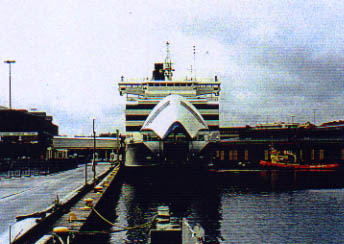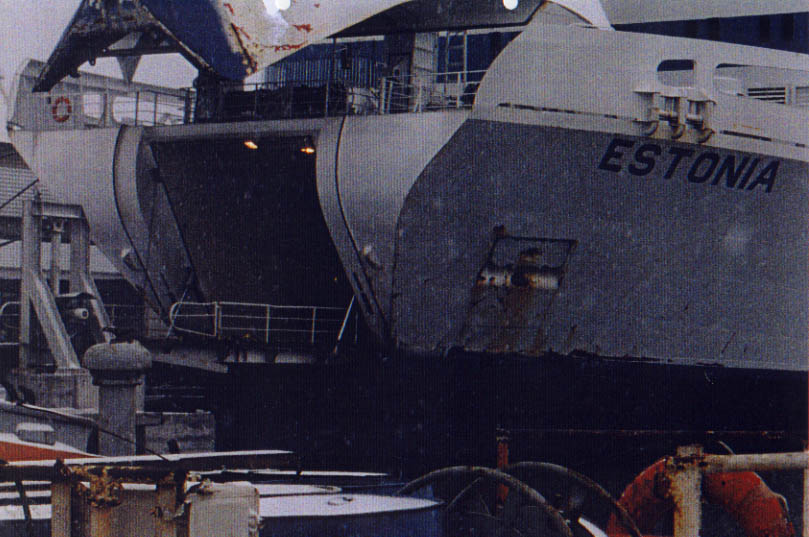
12.4
Observations on Board
Since no information about the operating history of the vessel was made available by owners/managers and also the Final Report of the JAIC contains very little in this respect, members of this 'Group of Experts' have spoken to previous passengers, advisers and crew members in order to find out how ESTONIA and her crew did perform during the 20 months in service under Estonian flag. Further information has come from viewers of the Swedish TV program 'EFTERLYS' after the ESTONIA casualty had been presented and viewers were requested to report about their own experiences on board the ESTONIA, which about 40 viewers did. The reports submitted during or immediately after the program - attached as Enclosure 12.4.145 - were analysed and the witnesses assumed to have made relevant observations were contacted by a Swedish speaking expert of this 'Group of Experts' either personally or by phone. The results are summarised in two faxes from Oy Mariner's Assistance Ltd. Ab, Helsinki to Marine Claims Partner (Germany) GmbH, Hamburg dated 30.07.97 - Enclosure 12.4.146 and dated 12.08.97 - Enclosure 12.4.147. The results of all observations made on ESTONIA and which are available to this 'Group of Experts' are summarised below.
One of the viewers of the 'EFTERLYS' program reported that he saw the ESTONIA in July 1994 at her berth in Stockholm with open visor and open bow ramp, which was categorically denied by N&T, ESCO and the JAIC members.The following picture proves it. It was made by a German tourist in July 1994.

12.4.1
Heavy weather, excessive speed and banging noises
»I have made, at least, 20-25 voyages on the ESTONIA and was, at least, 3 times on the bridge.
I am sending you the Swedish translation of an interview with Andi Meister published in the Estonian newspaper 'Postimees' on 16 January 1996.
Read the article and draw your own conclusions.
For me, having read his statement, it is a further confirmation that the guy doesn't know what he is talking about.
He made it quite clear that the causes of the catastrophe are exclusively technical.
Why is the excessive speed not taken into account?
In interviews and statement by the Estonian members of the JAIC it is said that the speed is of no relevance and had no effect on the catastrophe.
The chairman of the Commission has furthermore given wrong information in the interview when he stated that during the voyage there would be nobody on the car deck.The crew went safety rounds on the car deck.
At the same time I am asking the question, after having read in the interview about all the deficiencies that had been on the vessel, why were these obvious deficiencies not rectified when the vessel changed flags to Estonia?
The vessel was for a longer time sailing under Estonian flag and it should very well have been noted that the ramp was at the wrong place.
Or didn't they have competent masters and superintendents who were able to find that out?
According to the Estonian newspapers one of the conclusions in the Final Report shall be that the speed had no relevance for the catastrophe, which is totally wrong and not understandable because the vessel was proceeding with full engine power against a full storm. Many people, who do not even have own experience with good seamanship, will laugh about it. Already in the autumn (1995) the public has pointed to the fact that the Estonian Commission is biased. This is true, but the required consequences have not been taken.
The Commission itself does everything to make the Final Report, which is of substantial international interest, a farce, which is absolutely impossible.
Forsberg did indeed state in yesterday's 'Svenska Dagbladet' that the survivors had been questioned by the police. I am asking you, Hans: Is it possible for an external, who has never had to do with shipping or with how to handle a vessel, to ask the proper questions to establish a correct picture (scenario) of what had happened?«
Hans Rosengren never replied to this letter and the friendship between the two came to an end.
»My cabin was on the 4th deck, port side, forward and was overlooking the forecastle deck. I went to bed at 11.30 hours Estonian time. The waves were coming over the bow visor and were smashing with remarkable force against my cabin window. Each time the vessel was diving into a wave-trough there was banging - metal on metal - and I had the feeling that the visor was loose. It was impossible to sleep, so I got dressed and walked all around the vessel and subsequently I went as deep as I could inside the vessel. Down there I could also hear the banging, but it did not sound as dangerous. I went back to my cabin where the banging noises were much louder and frightening. I went back to the aft part of the vessel and found an empty sofa, where I slept until the next morning.«
The complete letter with office translation is attached as Enclosure 12.4.1.150.
12.4.2
Proceeding through iceThe picture below shows ESTONIA at her berth in Tallinn with open visor and bow ramp on 30.03.94, i.e. more or less at the end of the ice winter which had left visible traces to the visor's structure - see arrow.
Carl Övberg:
"I also made trips with ESTONIA in February/March 1994 when ESTONIA was acting like an icebreaker proceeding at full speed through heavy ice all the time until shortly before arrival. Once she almost stopped due to the very thick ice and then proceeded slowly ahead. The vessel was shaking and vibrating which was felt and heard all over the ship.
ESTONIA was always late arriving in Tallinn and also always delayed departing from Tallinn, but she was always on time in Stockholm no matter what the ice or wind conditions were like."The complete statement of Carl Övberg is attached as Enclosure 12.4.2.151.
Henning Frederiksson on 24.03.1994:
»It was stormy weather and ESTONIA was proceeding in open water at full speed with a following sea when she met pack ice, which she crashed into without any speed reduction. ESTONIA came fast into the pack ice with an enormous crash and had to go backwards and try again. There was 16 m/sec. storm, nevertheless, ESTONIA kept her high speed.«
The ice situation is demonstrated on the ice chart of 28.03.94 which is attached as Enclosure 12.4.2.152 and two photos showing the cruise vessel SALLY ALBATROSS sitting aground outside Porkkala (opposite Tallinn) in heavy ice during February/March 1994. The photos attached as Enclosure 12.4.2.153 clearly demonstrate the ice conditions which were prevailing at this time in the Gulf of Finland. The effect these ice conditions had on the visor and foreship of the ESTONIA can be seen on the photo below which was made on 24.03.94.

![]()